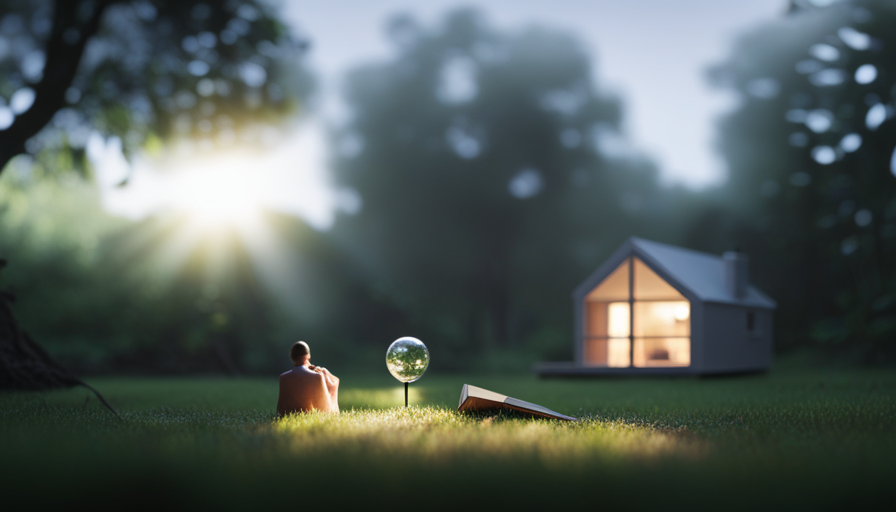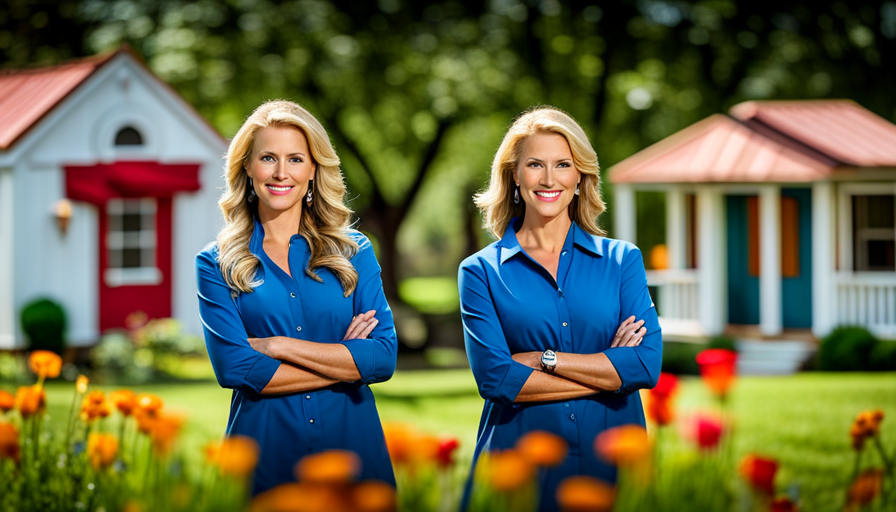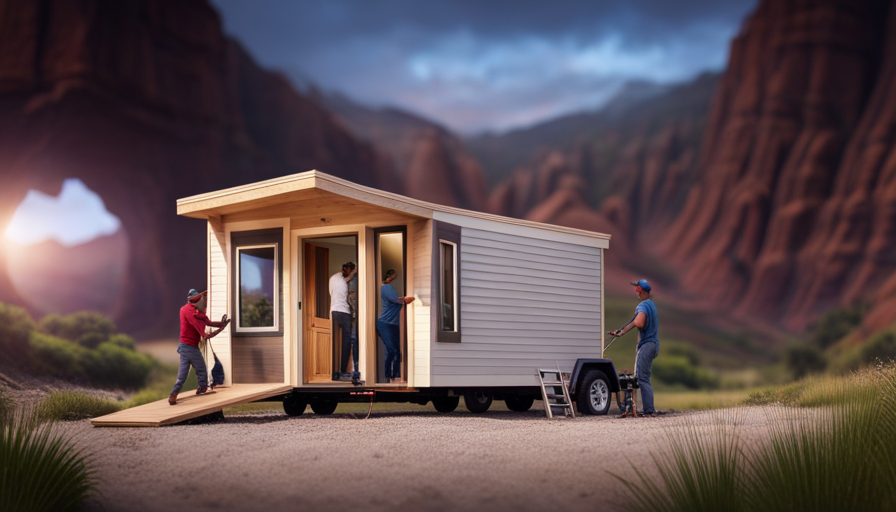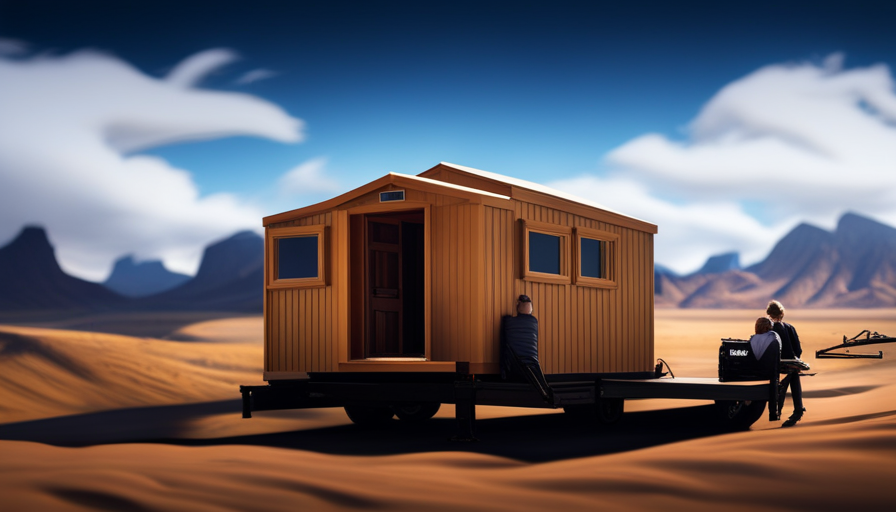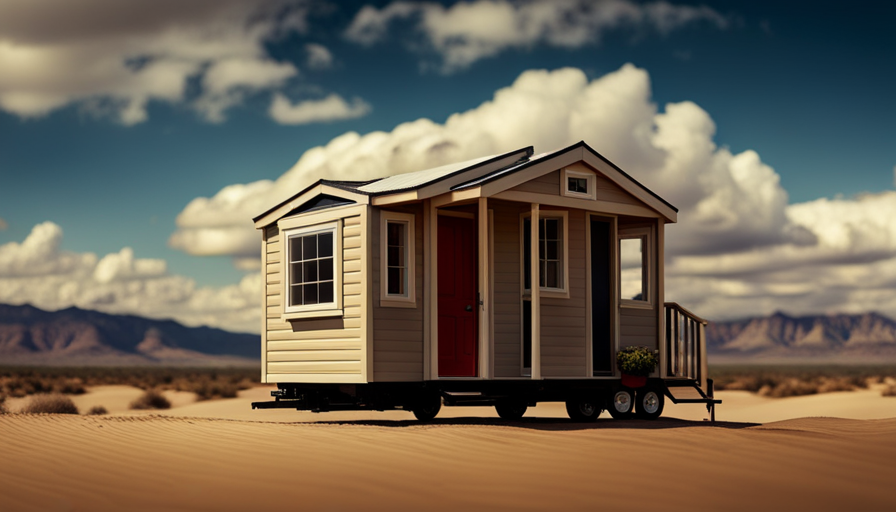In the symphony of life, our homes serve as the conductor, guiding our daily routines and providing sanctuary from the outside world. But recently, a new melody has emerged – the tiny house movement. These small dwellings have captivated many, promoting a simpler, more environmentally conscious way of living.
As I reflect on the notion of home, I can’t help but wonder: for how long can one truly thrive in a tiny house? In this article, I will explore the benefits, challenges, and considerations of living in a tiny house. From design principles that maximize comfort and functionality to essential amenities and the durability of these petite abodes, we will delve into the practical aspects of tiny house living.
Additionally, we will examine the social and community aspects that make this lifestyle so appealing. So, grab a seat and join me on this journey as we uncover the secrets to a fulfilling and lasting life in a tiny house.
Key Takeaways
- Tiny houses offer a simpler, more sustainable way of living
- Living in a tiny house allows for downsizing and decluttering
- Financial freedom is a major benefit of living in a tiny house
- Energy and water efficiency are crucial in a tiny house
Benefits of Living in a Tiny House
Living in a tiny house offers you the freedom to simplify your life and enjoy the many benefits that come with it. Minimalist living is at the heart of tiny house living, as it encourages you to downsize and declutter your belongings. By living with less, you can focus on what truly matters and eliminate unnecessary stress.
One of the biggest advantages of living in a tiny house is the financial freedom it provides. With a smaller space, your expenses are significantly reduced, allowing you to save money and live a more affordable lifestyle. Additionally, the compact size of a tiny house promotes energy efficiency and sustainability. It requires less energy to heat and cool, minimizing your environmental impact.
In the next section, we will explore design principles for comfort and functionality, ensuring that your tiny house is a cozy and practical home.
Design Principles for Comfort and Functionality
When it comes to designing a tiny house for comfort and functionality, there are three key principles to keep in mind.
The first is space-saving furniture and storage solutions, which are essential to maximize the limited space available.
Natural light and ventilation are also crucial, as they can make a small space feel more open and airy.
Finally, incorporating multi-purpose rooms and flexible layouts allows for versatility and adaptability in a tiny house, making it easier to accommodate different needs and functions.
Space-saving Furniture and Storage Solutions
With its ingenious space-saving furniture and storage solutions, a tiny house becomes a magical haven where every nook and cranny holds surprises waiting to be discovered. Here are three remarkable ways to maximize storage and create a functional living space:
-
Multifunctional Furniture: Transforming tables, fold-out beds, and hidden storage compartments are essential in a tiny house. They allow you to have a dining area that doubles as a workspace, a sofa that converts into a guest bed, and hidden drawers under stairs or under the floor.
-
Vertical Storage: Utilizing vertical space is crucial in a tiny house. Install floating shelves, hanging organizers, and wall-mounted cabinets to keep your belongings organized and easily accessible without taking up valuable floor space.
-
Utilizing Every Inch: Make use of every inch of your tiny house by incorporating storage solutions in unexpected places. Install shelves above doors, utilize the space under the stairs, and opt for furniture with built-in storage compartments.
By incorporating these space-saving furniture and storage solutions, you’ll create a highly functional and organized tiny house that maximizes every square inch.
Now let’s explore the importance of natural light and ventilation in creating a comfortable living environment.
Natural Light and Ventilation
To create a comfortable and inviting space, it’s essential to embrace the natural light and ventilation in your tiny home. Passive cooling and natural lighting are key aspects to consider for maximizing the livability of a small space.
By strategically placing windows and skylights, you can let in ample sunlight during the day, reducing the need for artificial lighting. Additionally, natural ventilation can be achieved through the use of well-placed windows and ventilation systems, ensuring a constant flow of fresh air. This not only helps regulate the temperature but also creates a healthier indoor environment.
By harnessing these natural elements, you can create a bright and airy atmosphere that makes your tiny home feel more spacious and comfortable.
Now let’s explore how multi-purpose rooms and flexible layouts can further optimize your living experience.
Multi-purpose Rooms and Flexible Layouts
Imagine a space where every room seamlessly transforms to meet your needs, offering endless possibilities for how you can use and enjoy your tiny home. With multi-functional furniture and clever space optimization techniques, tiny houses are designed to make the most out of every square inch.
Here are three ways in which multi-purpose rooms and flexible layouts can enhance your tiny living experience:
-
Convertible Furniture: From sofa beds to fold-out tables, multi-functional furniture allows you to easily switch between different activities and save space when not in use.
-
Room Dividers: By using sliding doors, curtains, or bookshelves, you can easily create separate areas within your tiny house without sacrificing the open feel of the space.
-
Loft Spaces: Utilizing vertical space is essential in tiny homes. Incorporating loft areas for sleeping or storage can free up valuable floor space for other activities.
By incorporating these design elements, tiny houses offer a practical and efficient living solution. Now let’s explore the next section about the essential amenities in a tiny house.
Essential Amenities in a Tiny House
When it comes to essential amenities in a tiny house, there are three key points to consider:
-
Kitchen and bathroom features should maximize space with compact appliances and clever storage solutions.
-
The sleeping and living areas should be designed for multi-purpose functionality, with convertible furniture and creative use of space.
-
Lastly, energy and water efficiency are crucial in a tiny house, so incorporating renewable energy sources and low-flow fixtures can help minimize environmental impact.
Kitchen and Bathroom Features
Living in a tiny house with a well-equipped kitchen and a luxurious bathroom creates a cozy and practical living space. The key to maximizing the functionality of these areas is to incorporate compact appliances and a minimalist design.
In the kitchen, a small refrigerator, a two-burner stove, and a compact dishwasher are essential. Having a well-organized pantry and storage space is crucial to maintain a clutter-free environment.
In the bathroom, a space-saving shower, a composting toilet, and a stylish sink can provide all the necessary amenities. By utilizing clever storage solutions such as hidden cabinets and wall-mounted shelves, every inch of space can be utilized efficiently.
These well-designed kitchen and bathroom features make daily tasks convenient and enjoyable in a tiny house. Transitioning into the subsequent section about sleeping and living areas, let’s explore the creative ways to optimize these spaces for comfort and functionality.
Sleeping and Living Areas
To truly optimize your space in a small home, it’s important to create multi-functional sleeping and living areas that can accommodate various needs and activities.
Did you know that 78% of tiny house dwellers report feeling happier and more content since downsizing?
When it comes to sleeping arrangements in a tiny house, creativity is key. Many tiny homes utilize loft spaces to maximize floor space, while others incorporate pull-out beds or convertible furniture.
Storage solutions are also crucial in these areas. Built-in cabinets, hidden compartments, and under-bed storage help keep belongings organized and out of sight.
By carefully planning and utilizing every inch of space, a tiny house can provide both comfortable living and functional sleeping areas.
Now, let’s explore how energy and water efficiency play a vital role in tiny house living.
Energy and Water Efficiency
Maximizing energy and water efficiency is crucial in order to fully optimize your small living space. By using energy saving appliances and implementing rainwater harvesting systems, you can significantly reduce your environmental impact and lower your utility bills. Energy saving appliances, such as energy star rated refrigerators and LED light bulbs, consume less electricity and help you save money in the long run. Additionally, rainwater harvesting allows you to collect and store rainwater for various household uses, such as watering plants and flushing toilets, reducing your dependence on municipal water supply.
Incorporating these efficient practices not only benefits the environment but also enhances your overall living experience in a tiny house. You’ll have more control over your energy consumption and water usage, allowing you to live comfortably and sustainably. Transitioning into the subsequent section about challenges and solutions for tiny house living, it’s important to address the potential obstacles that may arise and how to overcome them.
Challenges and Solutions for Tiny House Living
Overcoming the challenges of tiny house living means finding creative solutions that will allow me to fully enjoy the unique experience of this lifestyle.
One of the challenges is sustainable living. Living in a tiny house forces me to be more mindful of my consumption habits and encourages me to adopt a more eco-friendly lifestyle. I have to find ways to reduce waste, conserve energy, and use renewable resources.
Another challenge is dealing with zoning regulations. Many areas have strict regulations that make it difficult to legally park or live in a tiny house. However, by doing thorough research, working with local authorities, and finding communities that support tiny house living, I can find solutions to navigate these regulations.
Transitioning into the next section about the longevity and durability of tiny houses, it is important to address the challenges and solutions for building a tiny house that will withstand the test of time.
Longevity and Durability of Tiny Houses
When it comes to the longevity and durability of tiny houses, there are several key points to consider.
First and foremost, using quality materials and construction techniques is essential. This ensures that the structure will withstand the test of time and remain sturdy for years to come.
Additionally, proper maintenance and upkeep are crucial in preserving the integrity of the tiny house. Regular inspections and repairs will prevent any issues from escalating and ensure that the house remains in excellent condition.
Lastly, as our needs change over time, it’s important to adapt the tiny house accordingly. This could involve making renovations or additions to accommodate new requirements, ensuring that the house remains functional and comfortable for the long haul.
Quality Materials and Construction
To ensure a durable and long-lasting tiny house, you should use high-quality materials and expert construction. When it comes to sustainable materials, consider using reclaimed wood for the structural frame and siding. Not only does this reduce waste, but it also adds a unique charm to your tiny house.
Additionally, opt for eco-friendly insulation materials like cellulose or wool, which provide excellent thermal performance and are made from renewable resources.
As for construction techniques, choose methods that prioritize strength and stability, such as advanced framing or SIPs (Structural Insulated Panels). These techniques ensure a solid structure that can withstand the test of time.
By using sustainable materials and employing expert construction techniques, you can create a tiny house that will last for years to come.
Transitioning to the next section about proper maintenance and upkeep, it’s essential to…
Proper Maintenance and Upkeep
Maintaining and taking care of your tiny house is crucial for ensuring its longevity and preserving its charm. Here are some maintenance tips and organization strategies to keep your tiny house in top shape.
First, regularly inspect the exterior for any signs of damage or wear, such as cracks or leaks. Repairing these issues promptly will prevent further damage.
Additionally, keep the interior clean and clutter-free to maximize space and create a welcoming environment. Implement clever storage solutions, such as under-bed storage or built-in shelving, to make the most of limited space.
Regularly check and maintain the mechanical systems, such as plumbing and electrical, to prevent any unexpected issues.
By following these maintenance tips and staying organized, you can enjoy your tiny house for years to come. As your needs change over time, adapting your tiny house to accommodate those changes is the next step.
Adapting to Changing Needs Over Time
As life evolves and my needs shift, it’s important to embrace the flexibility and adaptability of my cozy abode to ensure it continues to be the perfect sanctuary for me. Aging in place is a common consideration for many tiny house dwellers. Modifying the tiny house to accommodate changing physical abilities is crucial. This may include installing handrails, widening doorways, or adding a ramp for accessibility. Additionally, as my lifestyle changes, I can modify the interior layout to better suit my evolving needs. Whether it’s converting a bedroom into a home office or creating more storage space, the tiny house can be customized to adapt to my ever-changing circumstances. By embracing these modifications, I can continue to enjoy the benefits of tiny house living while maintaining a comfortable and functional space. Transitioning into the subsequent section about the community and social aspects of tiny house living, it’s important to recognize that building a supportive network can enhance the overall experience.
Community and Social Aspects of Tiny House Living
Tiny House Communities and Events are an important aspect of tiny house living. These communities provide a space for like-minded individuals to come together and share their experiences, knowledge, and resources.
By joining a tiny house community, you can build relationships with others who understand and support your lifestyle choices. Additionally, there are numerous online and offline networks that offer support and guidance for tiny house dwellers, making it easier to navigate the challenges and enjoy the benefits of this unique way of living.
Tiny House Communities and Events
Living in a tiny house is like being part of a close-knit village, where neighbors become like family. Tiny house communities and events further enhance this sense of community. These communities are designed to foster connection and support among like-minded individuals who choose to live in tiny homes. They often have shared spaces and amenities, such as community gardens, recreational areas, and even communal kitchens. Tiny house festivals are also popular events where tiny house enthusiasts gather to showcase their homes, share ideas, and learn from one another. These events offer a unique opportunity to connect with others who share the same passion for minimalist living. By participating in these communities and events, tiny house dwellers can not only find support and inspiration but also stay up to date with the latest tiny house zoning regulations and resource-sharing practices. Transitioning into the next section, sharing resources and building relationships is essential for a thriving tiny house community.
Sharing Resources and Building Relationships
Get ready to connect with your fellow tiny house enthusiasts and build strong relationships by sharing resources within the community. Living in a tiny house is not just about the physical structure, but also about the sense of community that comes with it.
In a tiny house community, residents often work together to share resources, such as tools, appliances, and even land for gardening. This not only helps to minimize waste and reduce costs, but it also fosters a spirit of cooperation and support.
Building relationships within the tiny house community is essential for a fulfilling and sustainable lifestyle. By sharing resources, we not only lighten the load on our own wallets, but we also create a network of support that can provide guidance, inspiration, and friendship.
Transitioning into the subsequent section about ‘supportive online and offline networks’, we can explore the various ways in which these networks can further enhance the tiny house experience.
Supportive Online and Offline Networks
Sharing resources and building relationships are essential aspects of living in a tiny house. However, they can sometimes be challenging to achieve without a supportive network. That’s why it’s crucial to tap into online support and local meetups to connect with others who share the same lifestyle.
Online forums and social media groups provide a wealth of knowledge and advice from experienced tiny house dwellers. They offer a platform to ask questions, seek recommendations, and share successes and challenges. Additionally, attending local meetups allows you to meet like-minded individuals in your area, fostering a sense of community and support.
These networks not only provide practical tips but also offer emotional support and a sense of belonging. With the help of online support and local meetups, transitioning to a tiny house lifestyle becomes more manageable and enjoyable.
Now, let’s explore some considerations for making this lifestyle change.
Considerations for Transitioning to a Tiny House Lifestyle
Consider the practical aspects of transitioning to a tiny house lifestyle, like downsizing your belongings and adjusting to a simpler way of living.
Transitioning to a tiny house can present some challenges, both in terms of the physical move and the mental adjustment. One of the biggest challenges is downsizing your belongings and letting go of items that may hold sentimental value. It’s important to carefully consider what you truly need and what can be let go.
Financial considerations are also crucial when transitioning to a tiny house lifestyle. While tiny houses can be more affordable than traditional homes, there are still costs involved, such as purchasing or building the tiny house, as well as ongoing maintenance and utilities. It’s important to create a budget and plan accordingly to ensure a smooth transition to this unique way of living.
Frequently Asked Questions
How much does it cost to build a tiny house?
The cost of building a tiny house can vary depending on whether you choose to DIY or hire professional builders. DIY projects can cost as low as $10,000, while professional builders may charge anywhere from $20,000 to $100,000 or more.
It’s important to consider factors such as materials, labor, and customization when comparing costs. Regardless of the method, building a tiny house can be a cost-effective alternative to traditional homes.
Can I legally live in a tiny house on wheels?
Legally living in a tiny house on wheels is possible, but there are important factors to consider. One interesting statistic is that 68% of tiny house owners live in their homes full-time. However, legal considerations and parking restrictions can vary depending on the location.
It’s crucial to research local zoning laws and building codes to ensure compliance. Additionally, finding suitable parking spaces can be challenging, as some areas have restrictions on where you can park a tiny house on wheels.
What are the zoning regulations for tiny houses?
Tiny house zoning regulations vary depending on the location. It’s important to research and comply with local laws and regulations before setting up a tiny house. Some areas may allow tiny houses on wheels as long as they meet certain criteria, while others may require a permanent foundation. Living in a tiny house community can have many benefits, such as a sense of community, shared resources, and lower living costs.
How do you handle waste disposal in a tiny house?
Handling waste disposal in a tiny house requires a practical and eco-friendly approach. One popular solution is using composting toilets, which turn human waste into nutrient-rich compost. This not only eliminates the need for a traditional sewer system but also provides a sustainable way to fertilize plants.
Additionally, installing greywater systems allows for the reuse of water from sinks and showers, reducing water waste. These methods ensure efficient waste management in a tiny house while minimizing environmental impact.
Are there any financing options available for building or buying a tiny house?
There are several financing options available for building or buying a tiny house. One common option is to obtain a personal loan from a bank or credit union.
Another option is to use a home equity loan or line of credit if you already own a property.
Additionally, some tiny house builders offer in-house financing or rent-to-own programs.
It’s important to weigh the pros and cons of each option, such as interest rates, repayment terms, and eligibility requirements.
Conclusion
In conclusion, living in a tiny house offers numerous benefits such as financial freedom, reduced environmental impact, and a simplified lifestyle. Despite the challenges that come with limited space, the design principles and essential amenities can ensure comfort and functionality.
Additionally, the longevity and durability of well-built tiny houses make them a viable long-term housing option. For example, Sarah, a single mother of two, transitioned to a tiny house and found that it not only provided a cozy home for her family but also allowed them to focus on experiences rather than material possessions.
Making the decision to live in a tiny house requires careful consideration and planning, but it can lead to a fulfilling and sustainable lifestyle.
Hi, I’m Emma. I’m the Editor in Chief of Tiny House 43, a blog all about tiny houses. While tree houses are often associated with childhood, they can be the perfect adult retreat. They offer a cozy space to relax and unwind, surrounded by nature. And since they’re typically built on stilts or raised platforms, they offer stunning views that traditional homes simply can’t match. If you’re looking for a unique and romantic getaway, a tree house tiny house might just be the perfect option.
